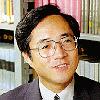- JST Home
- /
- Strategic Basic Research Programs
- /
 ERATO
ERATO- /
- Research Area/Projects/
- Completed/
- HIRAO Active Glass
HIRAO Active Glass

Research Director: Dr. Kazuyuki Hirao
(Professor, Graduate School of Engineering, Kyoto University)
Research Term: 1994-1999
The Hirao Active Glass Project took the view that understanding the effects of electromagnetic and other fields on glass is a key to making greatly value-added optical computing elements. This project studied glass under applied fields from the most basic physics and chemistry to experiments on applications practical to optical computing.
Research Results
Fast optical switches made of glass: Nonlinear optical glasses, such as Bi2O3-containing glasses, have been used to make extremely fast optical switches. A light beam is switched (100 femtoseconds; 1.6 terahertz repetition rate) by using a pumping beam, which changes the refractive index of the glass in the region of the optical communication signal to be switched.
Glass optical waveguides: Glass optical waveguides have been obtained by focusing femtosecond pulsed laser light (electric field power density > 1012 watt/cm2) within a variety of glasses, and then tracing out any desired pattern.
Crystal growth by femtosecond laser irradiation: The production of fibrous single-crystalline structures of BaB2O4 (BBO) in glass was obtained by focusing a laser beam onto a tiny region of a specially designed glass composition containing barium, silicon and boron.
Change of valence of ion species due to femtosecond radiation: The valence of various rare earth ions, such as Sm, which have important optical properties, could be modified by exposing to femtosecond 800 nm (infrared) radiation, called “optical oxidation/reduction,” due to the extremely high peak power, allowing multi-photon absorption.
Photo-induced long-lasting fluorescence in glass: Long-lasting (up to 10 hours) fluorescence phenomena have been found in a variety of rare-earth doped glasses after irradiation of femtosecond laser pulses. Red, green, and blue fluorescences have been observed in Pr3+-, Tb3+-, and Eu2+-doped glasses, respectively.
Optical poling of a glass material: By irradiating two laser beams the randomness of a dye in a glass matrix could be changed to an ordered direction. By this “optical poling” method a thin film of glass could be changed to second-harmonic-generating materials and a novel image memory demonstrated.
Simulation of glass: A theoretical computer simulation of glass SiO2 has been developed to analyze how electric fields change its electronic structures. It is also possible to calculate the change in an electron cloud when an electric field is present, and to consider possible changes in the composition of SiO2 to create better movement of the electron cloud, or some other effect.
Epilogue: All of the above-mention research is now being combined to produce a prototype of the first all-glass optical computer.

Generation of Second Harmonic by Induced Structure Inside Glass

Micrograph of Amorphous Structure Produced by Molecular Dynamics Simulation














